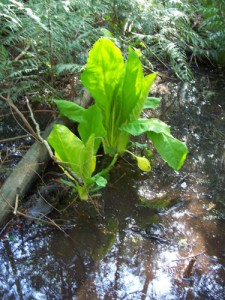The Western Skunk Cabbage lysichiton americanum is found in many areas of Gabriola where there are streams, wet ditches, swamps, moist forests and mucky seepage spots. One of the few native species belonging to the Arum family it flowers in early spring and is now highly visible because of its brilliant yellow hood (spathe), flower spike (spadix) and vivid green leaves. Do not be put off by the image the name projects, this is one amazing plant.
The Skunk Cabbage or Swamp Lantern as some prefer to call it is a robust, semi aquatic perennial, which can mature to a height of 150 cm. Below ground is a short rhizome and long fibrous roots, which anchor the plant firmly. The leaves are the largest of any native plant and are lance-shaped to broadly elliptic. The leaves often grow up to 1.5m long by 0.5m in width supported by short stout winged stalks. It’s densely packed; numerous greenish-yellow flowers grow on a tall cylindrical spike, which is hooded by a bright yellow bract. Often the flower bract appears before the leaves but due to exuberant growth of the leaves the bracts are overtaken with leaf growth. Embedded in the fleshy flower spike, pulpy berry like reddish fruit appear in June.
 This plant is so named because it does have a malodorous distinctive “skunky “ odor. Some say the odor is a pungent combination of skunk, carrion and garlic. So what is the purpose of this unusual smell? The flowers do have male and female organs but they still require pollination. The pollinators are flies and beetles, which are attracted to rotting vegetation, carrion or dung. Hence the odor attracts these insects and pollination takes place and the plant survives.
This plant is so named because it does have a malodorous distinctive “skunky “ odor. Some say the odor is a pungent combination of skunk, carrion and garlic. So what is the purpose of this unusual smell? The flowers do have male and female organs but they still require pollination. The pollinators are flies and beetles, which are attracted to rotting vegetation, carrion or dung. Hence the odor attracts these insects and pollination takes place and the plant survives.
The Skunk Cabbage is capable of generating its own heat. Even though snow may still be on the ground the spadix begins to oxidize starches that have been stored in the root system all winter. A by-product of this bio-chemical reaction is heat. Hot enough to melt the snow around the immediate area of the plant. This allows the hood to grow and open and release vapors to attract pollinators. The metabolic energy generated is equal to what a small rodent or hummingbird might use.
First Nations used the large waxy leaves to line berry baskets, berry-drying racks or steaming pits Bears after coming out of hibernation will search out the roots and consume as a laxative or cathartic.
Keep a look out for this splendid plant as you walk in the forest. Check your property and if you have a wet area encourage native plants that may be growing there. A wonderful book “Plants Of Coastal British Columbia” by Pojar and Mackinnon is an excellent field guide to native plants. Heading south on North Rd @ Horseshoe is a showy collection of this vibrant plant with its vivid yellow hoodie greeting all who pass by.
GROWLS WEBSITE www.growls.ca FOR ALL THINGS WILD
SKUNK CABBAGE LIKE OTHER MEMBERS OF THE ARUM FAMILY IS NOT AN EDIBLE PLANT AS THE LEAVES CONTAIN CALCIUM OXALATE CRYSTALS, WHICH CAUSE EXTREME BURNING SENSATION IN THE GASTRO-INTESTINAL TRACT.
Links
More about muskrats
Growls Website — For All things Wild
